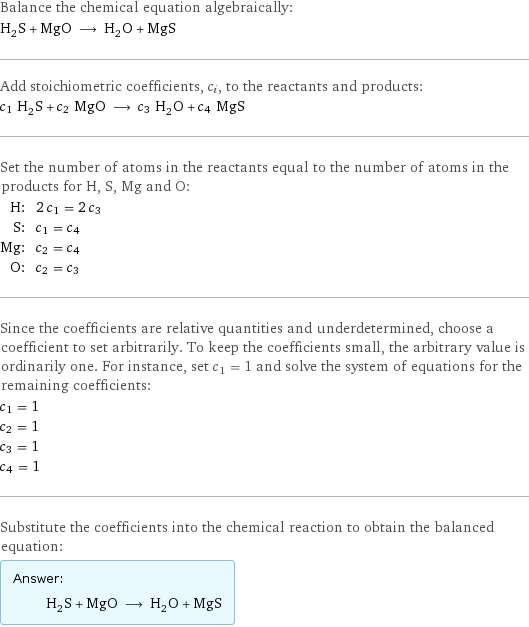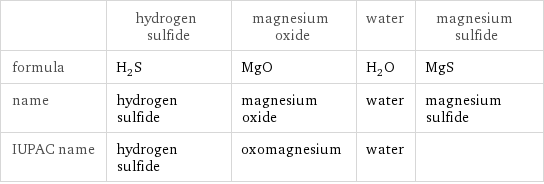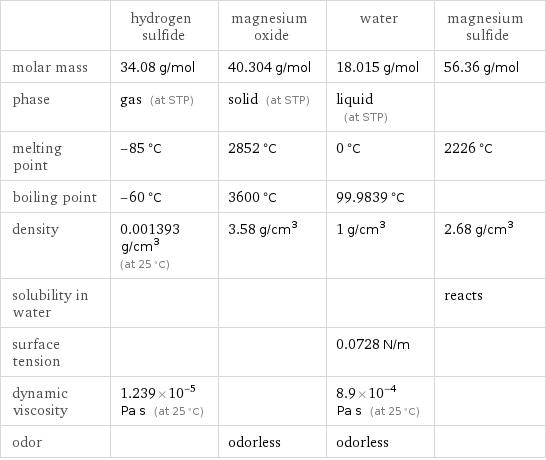Input interpretation

H_2S hydrogen sulfide + MgO magnesium oxide ⟶ H_2O water + MgS magnesium sulfide
Balanced equation

Balance the chemical equation algebraically: H_2S + MgO ⟶ H_2O + MgS Add stoichiometric coefficients, c_i, to the reactants and products: c_1 H_2S + c_2 MgO ⟶ c_3 H_2O + c_4 MgS Set the number of atoms in the reactants equal to the number of atoms in the products for H, S, Mg and O: H: | 2 c_1 = 2 c_3 S: | c_1 = c_4 Mg: | c_2 = c_4 O: | c_2 = c_3 Since the coefficients are relative quantities and underdetermined, choose a coefficient to set arbitrarily. To keep the coefficients small, the arbitrary value is ordinarily one. For instance, set c_1 = 1 and solve the system of equations for the remaining coefficients: c_1 = 1 c_2 = 1 c_3 = 1 c_4 = 1 Substitute the coefficients into the chemical reaction to obtain the balanced equation: Answer: | | H_2S + MgO ⟶ H_2O + MgS
Structures

+ ⟶ +
Names

hydrogen sulfide + magnesium oxide ⟶ water + magnesium sulfide
Equilibrium constant
![Construct the equilibrium constant, K, expression for: H_2S + MgO ⟶ H_2O + MgS Plan: • Balance the chemical equation. • Determine the stoichiometric numbers. • Assemble the activity expression for each chemical species. • Use the activity expressions to build the equilibrium constant expression. Write the balanced chemical equation: H_2S + MgO ⟶ H_2O + MgS Assign stoichiometric numbers, ν_i, using the stoichiometric coefficients, c_i, from the balanced chemical equation in the following manner: ν_i = -c_i for reactants and ν_i = c_i for products: chemical species | c_i | ν_i H_2S | 1 | -1 MgO | 1 | -1 H_2O | 1 | 1 MgS | 1 | 1 Assemble the activity expressions accounting for the state of matter and ν_i: chemical species | c_i | ν_i | activity expression H_2S | 1 | -1 | ([H2S])^(-1) MgO | 1 | -1 | ([MgO])^(-1) H_2O | 1 | 1 | [H2O] MgS | 1 | 1 | [MgS] The equilibrium constant symbol in the concentration basis is: K_c Mulitply the activity expressions to arrive at the K_c expression: Answer: | | K_c = ([H2S])^(-1) ([MgO])^(-1) [H2O] [MgS] = ([H2O] [MgS])/([H2S] [MgO])](../image_source/2a59d6d449547732dbbd9ab40d39ce85.png)
Construct the equilibrium constant, K, expression for: H_2S + MgO ⟶ H_2O + MgS Plan: • Balance the chemical equation. • Determine the stoichiometric numbers. • Assemble the activity expression for each chemical species. • Use the activity expressions to build the equilibrium constant expression. Write the balanced chemical equation: H_2S + MgO ⟶ H_2O + MgS Assign stoichiometric numbers, ν_i, using the stoichiometric coefficients, c_i, from the balanced chemical equation in the following manner: ν_i = -c_i for reactants and ν_i = c_i for products: chemical species | c_i | ν_i H_2S | 1 | -1 MgO | 1 | -1 H_2O | 1 | 1 MgS | 1 | 1 Assemble the activity expressions accounting for the state of matter and ν_i: chemical species | c_i | ν_i | activity expression H_2S | 1 | -1 | ([H2S])^(-1) MgO | 1 | -1 | ([MgO])^(-1) H_2O | 1 | 1 | [H2O] MgS | 1 | 1 | [MgS] The equilibrium constant symbol in the concentration basis is: K_c Mulitply the activity expressions to arrive at the K_c expression: Answer: | | K_c = ([H2S])^(-1) ([MgO])^(-1) [H2O] [MgS] = ([H2O] [MgS])/([H2S] [MgO])
Rate of reaction
![Construct the rate of reaction expression for: H_2S + MgO ⟶ H_2O + MgS Plan: • Balance the chemical equation. • Determine the stoichiometric numbers. • Assemble the rate term for each chemical species. • Write the rate of reaction expression. Write the balanced chemical equation: H_2S + MgO ⟶ H_2O + MgS Assign stoichiometric numbers, ν_i, using the stoichiometric coefficients, c_i, from the balanced chemical equation in the following manner: ν_i = -c_i for reactants and ν_i = c_i for products: chemical species | c_i | ν_i H_2S | 1 | -1 MgO | 1 | -1 H_2O | 1 | 1 MgS | 1 | 1 The rate term for each chemical species, B_i, is 1/ν_i(Δ[B_i])/(Δt) where [B_i] is the amount concentration and t is time: chemical species | c_i | ν_i | rate term H_2S | 1 | -1 | -(Δ[H2S])/(Δt) MgO | 1 | -1 | -(Δ[MgO])/(Δt) H_2O | 1 | 1 | (Δ[H2O])/(Δt) MgS | 1 | 1 | (Δ[MgS])/(Δt) (for infinitesimal rate of change, replace Δ with d) Set the rate terms equal to each other to arrive at the rate expression: Answer: | | rate = -(Δ[H2S])/(Δt) = -(Δ[MgO])/(Δt) = (Δ[H2O])/(Δt) = (Δ[MgS])/(Δt) (assuming constant volume and no accumulation of intermediates or side products)](../image_source/8c25a12f69fb9fe363d90b22bc946f41.png)
Construct the rate of reaction expression for: H_2S + MgO ⟶ H_2O + MgS Plan: • Balance the chemical equation. • Determine the stoichiometric numbers. • Assemble the rate term for each chemical species. • Write the rate of reaction expression. Write the balanced chemical equation: H_2S + MgO ⟶ H_2O + MgS Assign stoichiometric numbers, ν_i, using the stoichiometric coefficients, c_i, from the balanced chemical equation in the following manner: ν_i = -c_i for reactants and ν_i = c_i for products: chemical species | c_i | ν_i H_2S | 1 | -1 MgO | 1 | -1 H_2O | 1 | 1 MgS | 1 | 1 The rate term for each chemical species, B_i, is 1/ν_i(Δ[B_i])/(Δt) where [B_i] is the amount concentration and t is time: chemical species | c_i | ν_i | rate term H_2S | 1 | -1 | -(Δ[H2S])/(Δt) MgO | 1 | -1 | -(Δ[MgO])/(Δt) H_2O | 1 | 1 | (Δ[H2O])/(Δt) MgS | 1 | 1 | (Δ[MgS])/(Δt) (for infinitesimal rate of change, replace Δ with d) Set the rate terms equal to each other to arrive at the rate expression: Answer: | | rate = -(Δ[H2S])/(Δt) = -(Δ[MgO])/(Δt) = (Δ[H2O])/(Δt) = (Δ[MgS])/(Δt) (assuming constant volume and no accumulation of intermediates or side products)
Chemical names and formulas

| hydrogen sulfide | magnesium oxide | water | magnesium sulfide formula | H_2S | MgO | H_2O | MgS name | hydrogen sulfide | magnesium oxide | water | magnesium sulfide IUPAC name | hydrogen sulfide | oxomagnesium | water |
Substance properties

| hydrogen sulfide | magnesium oxide | water | magnesium sulfide molar mass | 34.08 g/mol | 40.304 g/mol | 18.015 g/mol | 56.36 g/mol phase | gas (at STP) | solid (at STP) | liquid (at STP) | melting point | -85 °C | 2852 °C | 0 °C | 2226 °C boiling point | -60 °C | 3600 °C | 99.9839 °C | density | 0.001393 g/cm^3 (at 25 °C) | 3.58 g/cm^3 | 1 g/cm^3 | 2.68 g/cm^3 solubility in water | | | | reacts surface tension | | | 0.0728 N/m | dynamic viscosity | 1.239×10^-5 Pa s (at 25 °C) | | 8.9×10^-4 Pa s (at 25 °C) | odor | | odorless | odorless |
Units
